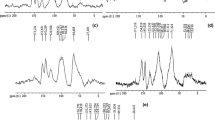Abstract
Wood preservatives based on protein borates, both obtained by just mixed water solutions of protein and boric acid, as well as in the case of premanufactured protein borates salts are shown to be a good method to greatly retard the leaching of boron from treated timber. Hence just premixed albumin + boric acid, premanufactured albumin borate and soja protein + boric acid all showed good preservative performance and much retarded leaching of boron. Accelerated biological tests indicated that boric acid partially fixed to timber by formation of a salt with albumin and other proteins which are then insolubilised by heat-induced coagulation can yield durability performances comparable to those obtained with CCA wood preservatives. The results of the biological tests show that protein borates, and particularly albumin borate, can be classified as long-term, wide-spectrum, ground-contact, heavy-duty wood preservatives, and are only composed of boric acid, a non-toxic to mammals biocide and of a non-toxic, natural, sometimes waste material, namely a protein. The mechanism is one of partially reversible rather than totally irreversible fixation of boron, leaving at all times small amounts of boron free to exercise its antifungal activity, but drastically diminishing its tendency to leach and greatly retarding its leaching. Boric acid leaching as a function of exposure time appears to tend to an equilibrium value. The timber is treated by just single stage, water-borne vacuum/pressure treating cycles as for traditional wood preservatives.
Zusammenfassung
Holzschutzmittel auf der Basis von Proteinboraten wurden entweder einfach durch Verrühren der wässrigen Lösungen von Protein und Borsäure hergestellt oder als vorgefertigte Protein-Borsäuresalze verwendet. Die Proteinsalze erwiesen sich als sehr wirkungsvoll gegen das Auswaschen von Bor(säure) aus behandeltem Holz. Borsäuresalze mit Albumin und Sojaprotein zeigtem zudem gute Schutzwirkung gegen Pilzbefall. Die Borsäure ist dabei teilweise fixiert durch Ausbilden von Salzbindungen an die Proteine, welche ihrerseits durch Wärmebehandlung, d.h. Koagulation unlöslich gemacht werden. Diese salze erreichen im beschleunigten biologischen Test ähnliche Schutzwirkungen wie CCA-Holzschutzmittel. Die biologischen Test zeigion, daß die Proteinborate, insbesondere Albuminborat als Holzschutzmittel für folgende Anwendungen charakterisiert werden kann: Langzeitwirkung, breites Spektrum, für Bodenkontakt und hochwirksam. Sie bestehen nur aus der für Säuger ungiftigen Borsäure und aus nicht toxischen, natürlichen, zuweilen auch als Abfallprodukte vorkommenden Proteinen. Die Wirkungsweise beruht auf der teilweise reversibelen Fixierung der Borsäure, wodurch einerseits jederzeit geringe Mengen freier Borsäure als pilzhemmender Stoff zur Verfügung steht, andererseits aber das übliche Auswaschen der Borsäure drastisch verlangsamt wird. Der Verlauf der Borsäure-Auswaschung scheint einem Gleichgewicht zuzustreben. Die Holzbehandlung geschieht in einem Schritt mit der für wässrige Holzschutzmittel üblichen Vakuum/Druck-Imprägnierung.
Similar content being viewed by others
References
Bourgeois CM, Leroux P (1982) Protéines animales: extraits, concentrés et isolats en alimentation humaine. Techniques et documentation. Lavoisier. Paris
Cheftel JC, Cuq JL, Lorient D (1989) Protéines animales. Techniques et documentation. Lavoisier. Paris
Doi E, Kitabatake N, Hatta H, Koseki T (1989) Relationship of SH groups to functionality of ovalbumine. in Food proteins (Kinsella, K. and J. Soucie, Eds) the American Oil Chemist Soc., Champlain, Illinois
Fox PJ (1982) The milk proteins, in Development in Dairy Chemistry (P.F. Fox, Ed.). Elsevier, London
Lowry OH, Rosebrough NJ, Farr AL, Randall RJ (1951) Protein measurement with the Folin phenol reagent. J. Biol. Chem. 193: 265–275
Peylo A (1993) Borbestimmung im Holz durch Extraktion mit Mannitol. Holz Roh-Werkstoff. 51:335–338
Pizzi A, Shelver G, Baecker AW (1995) Assignees: Biotrans UK, Silverducs BV, Dr Wolman GmBH. A method of treating timber — biological preservative, Patent cooperation treaty Application No. PCT-GB96/02102.
Robson B, Garnier J (1986) Introduction to proteins and protein engineering. Elsevier Science publishers. Amsterdam.
Smith PK, Krohn RI, Hermanson GT, Mallia AK, Gartner FH, Provenzano MD, Fujimoto EK, Goeke NM, Olson BJ, Klenk DC (1985) Measurement of proteins using bicinchoninic acid. Anal. Biochem. 150: 76–85
Thevenon M-F (1996). Ph.D. thesis progress report. Institute Polytechnique de Lorraine, Nancy, France
Thevenon M-F, Pizzi A, Haluk J-P (1997) Protein borates as nontoxic, long-term, wide-spectrum, ground-contact wood preservatives, Holzforschung, in press
Whitney R (1988) Proteins in milk in Fundamentals of dairy products. Van Nostrand-Reinhold. New York
Author information
Authors and Affiliations
Rights and permissions
About this article
Cite this article
Thevenon, M.F., Pizzi, A. & Haluk, J.P. Non-toxic albumin and soja protein borates as ground-contact wood preservatives. Holz als Roh- und Werkstoff 55, 293–296 (1997). https://doi.org/10.1007/s001070050231
Issue Date:
DOI: https://doi.org/10.1007/s001070050231




